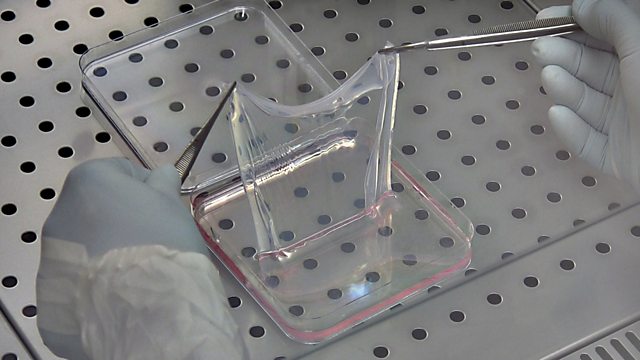
Skin Cell Therapies
Skin genetic engineering; Skin and vitamin D; Analysing the York Gospels; Science on Trial; Fossils in Dorset; Sleep Paralysis; 100 Women
Stem cell therapies are finally maturing. This week, an Italian and German team have used stem cells to grow back huge amounts of skin in a patient with a genetic disease. The patient, a 7 year old boy, was treated with his own genetically modified stem cells and has gone from being in a life-threatening position, to a full recovery. Fiona Watt, Director of the Centre for Stem Cells & Regenerative Medicine at Kings College London, told Andrew Luck-Baker more about the therapy.
A new study reports that elderly patients with severe burns who have higher levels of vitamin D recover more successfully than those with lower levels. The British researchers observed improved wound healing, fewer complications and less scarring. Their hope is that vitamin supplements could help burns patients to recover more quickly, once their findings are confirmed. Claudia Hammond speaks to Professor Janet Lord, Director of the Institute of Inflammation and Ageing at the University of Birmingham in the UK.
A medieval illuminated manuscript, over one-thousand years old, is still in used in religious ceremonies in the UK today. The York Gospels is exquisitely decorated and bound, providing important historical and artistic value. But new bio-archaeological analysis has shone light on the biological value of the book. The team have revealed which animal skins went to make the parchment and other fascinating discoveries about the biology contained beneath its covers. Jack Meegan reports from York Minster.
Stanford University professor Mark Z. Jacobson has filed a lawsuit, demanding $10 million in damages, against the peer-reviewed scientific journal Proceedings of the National Academy of Sciences (PNAS) and a group of eminent scientists (Clack et al.) Their study showed that Jacobson made improper assumptions in order to claim that he had demonstrated U.S. energy could be provided exclusively by renewable energy, primarily wind, water, and solar. Professor of Law Jonathan Adler of Case Western University has written about the case in the Washington Post and spoke to Roland Pease.
Fossils of the oldest-known ancestors of most living mammals, including human beings, have been unearthed in southern England. Teeth belonging to the extinct shrew-like creatures, which scampered at the feet of dinosaurs, were discovered in cliffs on the Dorset coast. Scientists who identified the specimens say they are the earliest undisputed fossils of mammals belonging to the line that led to humans. They date back 145 million years. 成人快手 science reporter Helen Briggs has been investigating.
"When your brain wakes up but your body doesn't" is how a sleep expert describes the phenomenon of sleep paralysis. Around 1 in 20 people will experience vivid hallucinations while falling asleep or waking up whilst being completely unable to move. Claudia Hammond talks to Chris French, Professor of Psychology at Goldsmiths University of London who conducted this new review, and Deborah Hyde describes what sleep paralysis is like for her.
All this week, the 成人快手 has been shining a spotlight on inspiring women in science as part of the 100 women series. Australian astronomer Karlie Noon tells us about Aboriginal astronomy and her journey as an indigenous woman in physics.
The Science Hour was presented by Claudia Hammond with comments from 成人快手 Science Correspondent Helen Briggs
Producer: Katy Takatsuki
(Picture: Scientists have created GM skin to treat a child with a devastating blistering disease 漏 CMR Unimore/PA Wire)
Last on
More episodes
Previous
Broadcast
- Sat 11 Nov 2017 12:06GMT成人快手 World Service Americas and the Caribbean
Podcast
-
![]()
Unexpected Elements
The news you know, the science you don't

